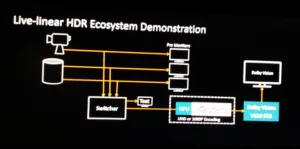Dolby’s Pat Griffis walked us around the Dolby booth to provide an update with a focus on using PQ in a live HDR broadcast workflow. The PQ workflow can be very versatile, he explained, and does not mean all the content needs to use an inverse PQ OETF. In fact, workflows are evolving that allow for content to use HLG, PQ and Sony’s S Log 3 OETFs during production. He noted that several HDR cameras from Sony, Canon and Grass valley, now include the inverse PQ OETF curve in the camera to start.
In many of the various workflows, once the content is finished and ready to be encoded, it is passed to the Dolby Content Management Unit (CMU) where scene-by scene metadata is added for a Dolby Vision version, or static metadata for an HDR10 version. It can also create an SDR version. These are then encoded in a separate box.
At NAB, Dolby told us about a new box to be called the HDR Processing Unit (HPU) that will combine the CMU and an HEVC encoder. This is essentially the CMU software loaded into an encoder as a pre-process step. It has already been prototyped and is undergoing trial evaluations, said Griffis. This will support UHD or 1080 HDR/SDR encoding.
Dolby’s solution for in the home is their VS10 STB chip. This can be integrated into a TV, set top box, a Chromecast stick or other media delivery platforms. One of the tricky parts of HDR is the handling of overlay graphics. These can be generated in the set top box and outside the video stream. Dolby showed a demo that handled showed how they were able to manage the brightness and white point of the graphics to suit the mode the TV was in: SDR or HDR.
The other issue Dolby addresses is channel changing where there is a mix of HDR and SDR channels. This requires the TV to switch modes, which on a TV without the VS10 chip, takes a full second to switch. Adding the VS10 to the chain eliminates this delay. – CC

